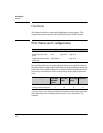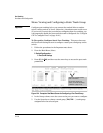
Port Trunking
Port Status and Configuration
Trunk Group Boundary Requirement for the Series 4100gl Switch 10/100/1000 Module (J4908A): Trunks must be created,
manually or dynamically, with ports from the same group, Group1 or Group2.
Group1: Ports 1-5, 7-11, 16
Group2: Ports 6, 12-15, 17-22
For example, a trunk made up of ports 3 - 5 is valid; a trunk made up of ports 4 - 6 is not (port 6 is a member of Group2, not
Group 1. Ports 21 and 22, for use with mini-GBICs, may be used to form a trunk.
Spanning Tree: Spanning Tree operates as a global setting on the switch (one instance of Spanning Tree per switch).
However, you can adjust Spanning Tree parameters on a per-port basis. A static trunk of any type appears in the Spanning
Tree configuration display, and you can configure Spanning Tree parameters for a static trunk in the same way that you
would configure Spanning Tree parameters on a non-trunked port. (Note that the switch lists the trunk by name—such
as Trk1—and does not list the individual ports in the trunk.) For example, if ports C1 and C2 are configured as a static
trunk named Trk1, they are listed in the Spanning Tree display as Trk1 and do not appear as individual ports in the Spanning
Tree displays.
In this example showing
part of the show spanning-
tree listing, ports C1 and C2
are members of TRK1 and
do not appear as individual
ports in the port
configuration part of the
listing.
When Spanning Tree forwards on a trunk, all ports in the trunk will be forwarding. Conversely, when Spanning Tree blocks
a trunk, all ports in the trunk are blocked.
Note: A dynamic LACP trunk operates only with the default Spanning Tree settings and does not appear in the Spanning
Tree configuration display
or show ip igmp listing.
If you remove a port from a static trunk, the port retains the same Spanning Tree settings that were configured for the trunk.
IP Multicast Protocol (IGMP): A static trunk of any type appears in the IGMP configuration display, and you can configure
IGMP for a static trunk in the same way that you would configure IGMP on a non-trunked port. (Note that the switch lists
the trunk by name—such as Trk1—and does not list the individual ports in the trunk.) Also, creating a new trunk
automatically places the trunk in IGMP Auto status if IGMP is enabled for the default VLAN. A dynamic LACP trunk
operates only with the default IGMP settings and does not appear in the IGMP configuration display or
show ip igmp
listing.
VLANs: Creating a new trunk automatically places the trunk in the DEFAULT_VLAN, regardless of whether the ports in
the trunk were in another VLAN. Similarly, removing a port from a trunk group automatically places the port in the default
VLAN. You can configure a static trunk in the same way that you configure a port for membership in any VLAN.
Note: For a dynamic trunk to operate in a VLAN other than the default VLAN (DEFAULT_VLAN), GVRP must be enabled.
See “Trunk Group Operation Using LACP” on page 12-18.
Port Security: Trunk groups (and their individual ports) cannot be configured for port security, and the switch excludes
trunked ports from the
show port-security listing. If you configure non-default port security settings for a port, then
subsequently try to place the port in a trunk, you will see the following message and the command will not be executed:
< port-list > Command cannot operate over a logical port.
Monitor Port:
Note: A trunk cannot be a monitor port. A monitor port can monitor a static trunk but cannot monitor a dynamic LACP
trunk.
12-9


















